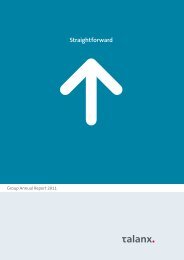Values
Values
Values
Create successful ePaper yourself
Turn your PDF publications into a flip-book with our unique Google optimized e-Paper software.
140<br />
Group Financial Statements<br />
Notes<br />
Exchange Rate Risk<br />
Bertelsmann is exposed to exchange rate risk in various currencies.<br />
Its subsidiaries are advised, but not obliged, to hedge<br />
themselves against exchange rate risks in the local reporting<br />
currency by signing forward agreements with banks that possess<br />
an excellent credit rating. Loans within the Group that are<br />
subject to exchange rate risk are hedged using derivatives.<br />
A number of subsidiaries are based outside the euro zone.<br />
Th e resulting translation risk is managed through the relation-<br />
Interest Rate Risk<br />
Interest rate risk is managed on the basis of the Group’s planned<br />
net fi nancial debt and expected interest rate movements.<br />
Available funds are generally invested at fl oating rates for<br />
periods of less than one year.<br />
Liquidity Risk<br />
Liquidity risks may arise through a lack of roll-over fi nancing<br />
(liquidity risk in a narrower sense), delayed receipt of payment<br />
and unforeseen expenditure (budgeting risk). Budgeting risk<br />
concerns deviations in actual spending versus budget and reserve<br />
amounts. In a narrower sense, liquidity risk depends on<br />
the volume of debt due within a given period.<br />
Liquidity risk is managed and monitored on an ongoing<br />
basis with reference to the budget for current and future years.<br />
Default Risk<br />
The Group is exposed to default risks in the amount of the invested<br />
cash and cash equivalents and the positive fair value<br />
of the derivatives in its portfolio. Money market securities<br />
and other financial instruments are transacted exclusively<br />
with a defined group of banks with an excellent credit rating<br />
(“core banks”). Bertelsmann has expanded internal policy<br />
restrictions concerning the investment of cash and cash<br />
equivalents since the outbreak of the financial crisis. Core<br />
banks are constantly monitored on the basis of quantitative<br />
ship of economic debt to operating EBITDA of key currency<br />
areas. Th e objective is to achieve a reasonable relationship<br />
between economic debt and operating results for each major<br />
currency area in the long term; Bertelsmann uses the upper<br />
limits for leverage defi ned for the Group as a performance indicator.<br />
In the period under review, the proportion of fl oating-rate liabilities<br />
was reduced by way of repayment.<br />
New and unplanned transactions (e. g., acquisitions) are continuously<br />
tracked. Th e maturity profi le of fi nancial assets and<br />
liabilities is also reconciled on a regular basis. Budget risks are<br />
managed through eff ective cash management and constant<br />
monitoring of projected versus actual cash fl ows. Debt maturities<br />
are also diversifi ed to ensure that rising fi nancing costs do<br />
not have a short-term impact. Lines of credit are also maintained<br />
for unplanned expenditures.<br />
and qualitative criteria (rating, CDS spreads, stock price,<br />
etc.) and rated for creditworthiness. Counterparty limits<br />
determined on the basis of credit ratings reflect cash holdings<br />
and positive fair value; adherence to limits is monitored<br />
daily. Funds are invested very short-term in some cases to<br />
preserve flexibility in the event of credit rating changes. Default<br />
risks arising from trade accounts payable are partially<br />
mitigated through credit insurance coverage.<br />
Bertelsmann Annual Report 2009
















